Kathrynray
On this page, you find all documents, package deals, and flashcards offered by seller kathrynray.
- 16
- 0
- 0
Community
- Followers
- Following
16 items
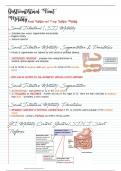
Motility of the Small and Large Intestines
Starts off with the motility of the small intestine, explaining the 2 main mechanisms, with definitions and what they entail. Then goes onto the reflexes that are involved in the small intestine motility, it includes diagrams which makes it easier to understand. Then goes onto explain motility in the large intestine, explaining the difference between motility of the 2 different intestines and the mechanisms. Then goes on to explain the reflexes involved in the role of defecation, and the process...
- Class notes
- • 3 pages •
Starts off with the motility of the small intestine, explaining the 2 main mechanisms, with definitions and what they entail. Then goes onto the reflexes that are involved in the small intestine motility, it includes diagrams which makes it easier to understand. Then goes onto explain motility in the large intestine, explaining the difference between motility of the 2 different intestines and the mechanisms. Then goes on to explain the reflexes involved in the role of defecation, and the process...
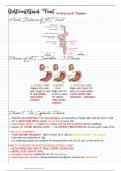
Gastrointestinal Tract Secretions and Regulation
Introduces the 3 different phases of secretion within the GI Tract. Then starts to go into more depth of each phase, starting with the cephalic phase. Goes into detail about what triggers the phase, as well as stating the importance of it, and the receptors, cell types and enzymes present. It explains the different reflexes and how different systems also play a role, e.g. the nervous system. Also contains examples of how disease can affect how the gastric acid is secreted and how medical interve...
- Class notes
- • 6 pages •
Introduces the 3 different phases of secretion within the GI Tract. Then starts to go into more depth of each phase, starting with the cephalic phase. Goes into detail about what triggers the phase, as well as stating the importance of it, and the receptors, cell types and enzymes present. It explains the different reflexes and how different systems also play a role, e.g. the nervous system. Also contains examples of how disease can affect how the gastric acid is secreted and how medical interve...
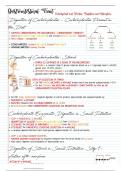
Carbohydrate and Protein Digestion and Absorption in the Gastrointestinal Tract
Starts off by introducing the different groups of carbohydrates e.g. simple and complex, which is good if haven't studied biochemistry. Then goes on to explain how carbohydrates are digested in different sections of the GI system, mainly the small intestines. It explains the role of the enzyme called alpha-amylase and the vital role it plays in the breakdown of carbohydrates. Then gives an example of how fasting affects the absorption of carbohydrates, in particular glucose and fructose. Then g...
- Class notes
- • 4 pages •
Starts off by introducing the different groups of carbohydrates e.g. simple and complex, which is good if haven't studied biochemistry. Then goes on to explain how carbohydrates are digested in different sections of the GI system, mainly the small intestines. It explains the role of the enzyme called alpha-amylase and the vital role it plays in the breakdown of carbohydrates. Then gives an example of how fasting affects the absorption of carbohydrates, in particular glucose and fructose. Then g...
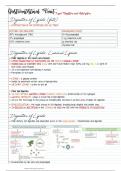
Lipid Digestion and Absorption in the Gastrointestinal Tract
Provides a good base knowledge of how fats are digested throughout the GI system and how they are then absorbed. Introduces the different types of fat composition that are present within the GI tract, as well as introduces the role of key enzymes, e.g. lipase. and their role in digestion. Then starts to explain the 4 different stages that are vital part of digestion and breaks them down further with a more in-depth review with images to help understand better.
- Class notes
- • 4 pages •
Provides a good base knowledge of how fats are digested throughout the GI system and how they are then absorbed. Introduces the different types of fat composition that are present within the GI tract, as well as introduces the role of key enzymes, e.g. lipase. and their role in digestion. Then starts to explain the 4 different stages that are vital part of digestion and breaks them down further with a more in-depth review with images to help understand better.
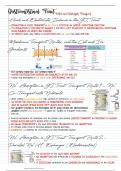
Water and Electrolyte Transport of the Gastrointestinal Tract
Provides a good introduction to the different types of ways that electrolytes and water can be balanced as part of the GI system. It introduces the membrane routes that are taken both at a cellular level and ion. Then goes on to explain the different chemical transports taken and their routes e.g. sodium co-transport with nutrients. Most information is on the sodium transport, but there is also a good amount of information on the potassium and chloride transport, and there are pictures within ea...
- Class notes
- • 3 pages •
Provides a good introduction to the different types of ways that electrolytes and water can be balanced as part of the GI system. It introduces the membrane routes that are taken both at a cellular level and ion. Then goes on to explain the different chemical transports taken and their routes e.g. sodium co-transport with nutrients. Most information is on the sodium transport, but there is also a good amount of information on the potassium and chloride transport, and there are pictures within ea...
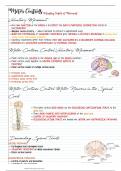
Voluntary Control of Movement
Introduces what voluntary movement is, before going into the areas of the brain that control these voluntary movements. It explains how each area has a vital role to play and the pathway/tracts that they use to elicit a voluntary response. There is also information about a study that was conducted on the part of the cortical motor neurones in monkeys, and the key findings that were found through the experiment. The end of the lecture follows the networks that are involved in creating the volunta...
- Class notes
- • 5 pages •
Introduces what voluntary movement is, before going into the areas of the brain that control these voluntary movements. It explains how each area has a vital role to play and the pathway/tracts that they use to elicit a voluntary response. There is also information about a study that was conducted on the part of the cortical motor neurones in monkeys, and the key findings that were found through the experiment. The end of the lecture follows the networks that are involved in creating the volunta...

Subcortical Control of Movement
An introduction to parts of the brain that are in control of the process of movement. It gives a brief overview of the parts of the brain involved, before going into more detail about the function and explanation of the receptors, tissues, etc. involved in that area of the brain. It also includes information about the different types of pathways that areas of the brain used for signalling, as well as discussing some diseases that can have an affect on the pathway of the brain, which then impact ...
- Class notes
- • 3 pages •
An introduction to parts of the brain that are in control of the process of movement. It gives a brief overview of the parts of the brain involved, before going into more detail about the function and explanation of the receptors, tissues, etc. involved in that area of the brain. It also includes information about the different types of pathways that areas of the brain used for signalling, as well as discussing some diseases that can have an affect on the pathway of the brain, which then impact ...
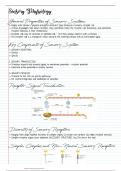
Sensory Physiology
Gives an in-depth look into sensory physiology. This introduces you to the general properties of the sensory system to ease you into the lecture before going into the key properties and pathways. You are then introduced to the 4 different types of receptors that make-up the sensory pathway, first with a general overview and then each goes into more detail and explanation further down. There are examples throughout, such as the receptors that are found in the skin and their mechanism of action, a...
- Class notes
- • 6 pages •
Gives an in-depth look into sensory physiology. This introduces you to the general properties of the sensory system to ease you into the lecture before going into the key properties and pathways. You are then introduced to the 4 different types of receptors that make-up the sensory pathway, first with a general overview and then each goes into more detail and explanation further down. There are examples throughout, such as the receptors that are found in the skin and their mechanism of action, a...
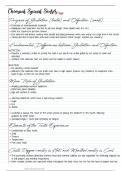
Chemical Senses - Taste
A nice overview of taste and smell, by giving definitions of each and showing the difference in chemical signalling between each sense. It explains the role of gustation and goes into detail about the ligands and receptors involved in the process of taste. It also explains physiological parts of the anatomy and the cells that are found within that anatomy. It then finishes off by talking about the mechanisms that are involved in the different cell-types found in the taste sense.
- Class notes
- • 4 pages •
A nice overview of taste and smell, by giving definitions of each and showing the difference in chemical signalling between each sense. It explains the role of gustation and goes into detail about the ligands and receptors involved in the process of taste. It also explains physiological parts of the anatomy and the cells that are found within that anatomy. It then finishes off by talking about the mechanisms that are involved in the different cell-types found in the taste sense.

Overview of the Chemical Process of Smell
A brief introduction into the chemical process involved in the smelling process. Gives a nice introduction to the types of tissue and receptors involved. At the end of the notes, there is a a bit of background into covid-19 and how one of the main symptoms (loss of smell) came out and the biological and biochemical reasoning.
- Class notes
- • 2 pages •
A brief introduction into the chemical process involved in the smelling process. Gives a nice introduction to the types of tissue and receptors involved. At the end of the notes, there is a a bit of background into covid-19 and how one of the main symptoms (loss of smell) came out and the biological and biochemical reasoning.
